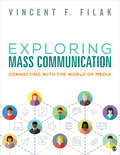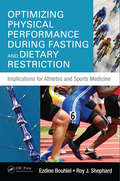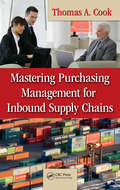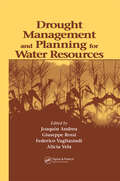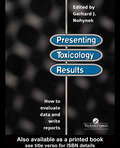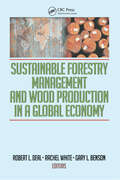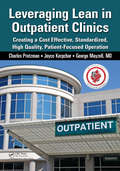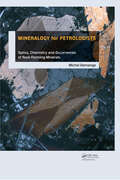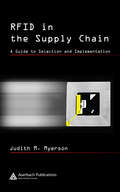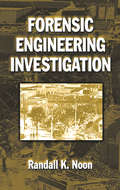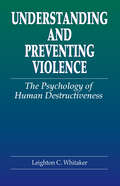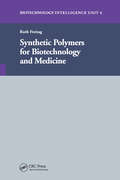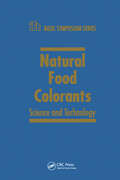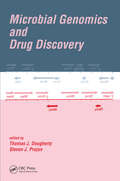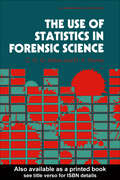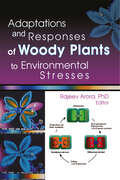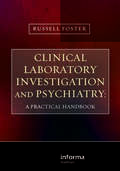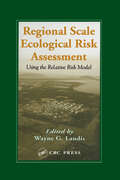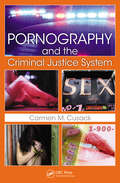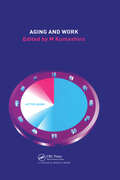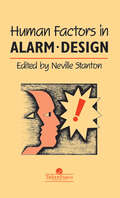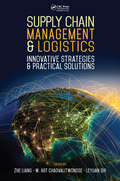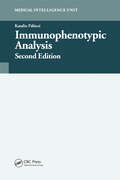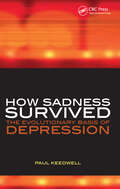- Table View
- List View
Exploring Mass Communication: Connecting with the World of Media
by Vincent F. FilakVincent F. Filak named next editor for Journalism and Mass Communication Educator Exploring Mass Communication examines the many paths that led to our digital media world and how digital media both connects and disconnects us. While providing the need-to-know concepts, history, and theories, Vincent F. Filak urges students to critically think about how media affects them, and how they can best engage with media to improve their everyday lives. Through Filak′s conversational and personable style, the text interweaves inclusivity and diversity throughout, presenting a modern and fresh approach that today’s students will connect with. This title is accompanied by a complete teaching and learning package. Learning Platform / Courseware Sage Vantage is an intuitive learning platform that integrates quality Sage textbook content with assignable multimedia activities and auto-graded assessments to drive student engagement and ensure accountability. Unparalleled in its ease of use and built for dynamic teaching and learning, Vantage offers customizable LMS integration and best-in-class support. It’s a learning platform you, and your students, will actually love.. Assignable Video with Assessment Assignable video (available in Sage Vantage) is tied to learning objectives and curated exclusively for this text to bring concepts to life. LMS Cartridge: Import this title’s instructor resources into your school’s learning management system (LMS) and save time. Don’t use an LMS? You can still access all of the same online resources for this title via the password-protected Instructor Resource Site.
Optimizing Physical Performance During Fasting and Dietary Restriction: Implications for Athletes and Sports Medicine
by Ezdine Bouhlel Roy J. ShephardOptimizing Physical Performance During Fasting and Dietary Restriction examines the effects of sustained fasting and food restrictions on metabolism and physical performance in athletes. It provides broad coverage including both religious and non-religious fasting and dietary restrictions.This practical and evidence-based guide outlines recent find
Mastering Purchasing Management for Inbound Supply Chains
by Thomas A. CookImporting finished products, components, and raw materials has become the status quo in today‘s increasingly competitive business landscape. The lessons of inbound supply, however, can be very costly if learned through a trial-and-error approach especially foreign purchasing. By not understanding the parameters of landed costs alone, purchasing man
Drought Management and Planning for Water Resources
by Joaquín Andreu Giuseppe Rossi Federico Vagliasindi Alicia VelaDroughts and their management are a serious challenge to water resource professionals. While droughts predominate in arid regions, their frequency and severity in more temperate regions with more abundant rainfall have been on the rise. Drought Management and Planning for Water Resources provides an essential collection of planning and manag
Presenting Toxicology Results: How to Evaluate Data and Write Reports
by G. J. NohynekWritten in such a way as to make it accessible to toxicologists who do not have English as a first language, this book focuses on evaluating, interpreting and reporting results of regulatory toxicology studies.
Sustainable Forestry Management and Wood Production in a Global Economy
by Robert L Deal Rachel White Gary BensonA global view of responsible forestry management Sustainable Forestry Management and Wood Production in a Global Economy examines emerging issues and key strategies for sustaining wood production while maintaining other forest resources. Internationally recognized forestry experts explore a broad range of topics on sustainable forestry at t
Leveraging Lean in Outpatient Clinics: Creating a Cost Effective, Standardized, High Quality, Patient-Focused Operation
by Charles Protzman Joyce Kerpchar George MayzellThis book is part of a series of titles that are a spin-off of the Shingo Prize-winning book Leveraging Lean in Healthcare: Transforming Your Enterprise into a High Quality Patient Care Delivery System. Each book in the series focuses on a specific aspect of healthcare including emergency departments, medical laboratories, outpatient clinics, ancil
Handbook of Thermoplastic Piping System Design (Mechanical Engineering)
by Thomas Sixsmith Reinhard HanselkaOffers coverage of design, engineering, chemical resistance, costs, standards, codes and specifications. The text provides a resistance guide that lists over 800 chemicals and nearly 400 trade names cross-referenced to formal chemical names, covering all known chemical resistance data for the most popular thermoplastic piping systems. The book cove
Mineralogy for Petrologists: Optics, Chemistry and Occurrences of Rock-Forming Minerals
by Michel Andre DemangeThis book provides a categorized and visualized overview and presents microscopic observations, systematic mineralogy, chemistry, geology, stability, paragenesis, occurrence and use in petrology of 137 minerals. Structural formula calculations are included in the appendix. Consists of a set of book and downloadable resources for students and practically-oriented researchers and professionals in geology, geological, mining, and mineral resources engineering who need a reference of mineralogy, applied to petrology.The downloadable resources contain 384 color plates with mineral microscopic visuals under various circumstances.
RFID in the Supply Chain: A Guide to Selection and Implementation
by Judith M. MyersonGiving organizations the ability to track, secure, and manage items from the time they are raw materials through the life-cycle of the product, radio frequency identification (RFID) makes internal processes more efficient and improves overall supply chain responsiveness. Helping you bring your organization into the future, RFID in the Supply Ch
Forensic Engineering Investigation
by Randall K. NoonForensic Engineering Investigation is a compendium of the investigative methodologies used by engineers and scientific investigators to evaluate some of the more common types of failures and catastrophic events. In essence, the book provides analyses and methods for determining how an entity was damaged and when that damage may have legal consequen
Understanding and Preventing Violence: The Psychology of Human Destructiveness (Pacific Institute Series on Forensic Psychology)
by Leighton C. WhitakerMore violence has been perpetrated in the 20th century than in the two previous centuries combined. Understanding and Preventing Violence: Unmasking the Mentality of Human Destructiveness elucidates the mentality of destructive behavior with the hopes that in the future, the trend may be reversed through enlightenment. But in order to choose to be
Synthetic Polymers for Biotechnology and Medicine
by Ruth FreitagThis book covers topics including the delivery of biologicals using synthetic polymers, cell encapsulation, and gene delivery. It deals with the use of synthetic polymers for the purpose of isolating biologicals by describing the use of stimulus-responsive polymers.
Natural Food Colorants: Science and Technology
by Gabriel J. Lauro Jack FrancisThis work focuses on the preparation, structure, chemistry, functional properties, stability, handling and applications of naturally-derived colorants approved for use in food products in the USA, Europe and Asia. It presents studies that investigate whether natural colorants reduce risk of heart disease, specific types of cancer, and other conditi
Microbial Genomics and Drug Discovery
by Thomas J. Dougherty Steven J. ProjanExploring innovative routes of drug discovery in the postgenomic era, Microbial Genomics and Drug Discovery examines bioinformatic and genomic approaches for the identification, detection, selection, and validation of new antibacterial targets and vaccine candidates. The book discusses potential pathways for effective infection control, inhibition of antibacterial resistance, and acceleration of the drug discovery process. This comprehensive reference describes procedures to recognize common targets in various bacterial species for the design of broad-spectrum antibiotics and clearly illustrates the use of pathway tools in a genomics-based drug discovery project.
The Use Of Statistics In Forensic Science
by C. G. Aitken David A. StoneyDescribes ways of assessing forensic science evidence and the means of communicating the assessment to a court of law. The aim of this work is to ensure that the courts consider seriously the probability of the evidence of association.
Adaptations and Responses of Woody Plants to Environmental Stresses
by Rajeev AroraDiscover what improves stress resistance to cold in woody plants used in horticulture! Adaptations and Responses of Woody Plants to Environmental Stresses covers the latest and most significant advances in woody plant stress research. Few books focus on the low-temperature stress biology of woody plants that are of horticultural importance
Clinical Laboratory Investigation and Psychiatry: A Practical Handbook
by Russell FosterA precise, practical handbook, Clinical Laboratory Investigation and Psychiatry is an invaluable tool that explores day-to-day psychiatric practices and various situations that arise in the field of mental health. This unique and resourceful textbook is a must-have aid for front-line clinicians, psychiatrists, and other professionals working in the
Regional Scale Ecological Risk Assessment: Using the Relative Risk Model
by Wayne G. LandisAs debates over how relative risk can be used to shape landscape-scale environmental management intensify, Regional-Scale Risk Assessment demonstrates the capabilities of RRM using nine case studies in the Pacific Northwest, Pennsylvania, Brazil, and Tasmania. The authors use a process of ranking and filters to interrelate different kinds of risks
Pornography and The Criminal Justice System
by Carmen M. CusackThis volume assembles hundreds of cases and studies to provide the most accurate and comprehensive picture of the status of pornography in the criminal justice system. Presenting high-level research in an accessible and organized manner, it explores a range of topics, including investigating and prosecuting a case, arguments favoring and opposing d
Aging and Work
by Masaharu KumashiroImprovements in health care and quality of life in recent years have led to a marked aging of the world's population, especially in well-developed regions. In the near future, this problem will spread to developing countries. The growing need to promote the health and function of aging workers presents new challenges as well as new opportunities.
Human Factors in Alarm Design
by Neville StantonFocusing on the application of human factors and ergonomics in the design of alarm systems, this book brings together all the disparate areas in a single volume.; The aim of the book is to present current human factor issues regarding alarm design in a variety of setting, such as industrial alarm systems in process industries, aviation, autom
Supply Chain Management and Logistics: Innovative Strategies and Practical Solutions (Industrial and Systems Engineering Series)
by Zhe Liang Wanpracha Art Chaovalitwongse Leyuan ShiDesigned by practitioners for practitioners, Supply Chain Management and Logistics: Innovative Strategies and Practical Solutions provides a wide-spectrum resource on many different aspects involved in supply chain management, including contemporary applications. With contributions from leading experts from all over the world, the book includes innovative strategies and practical solutions that address problems encountered by enterprise in management of supply chain and logistics. It details general techniques and specific approaches to a broad range of important, inspiring, and unanswered questions in the field.The book is organized around four major research themes in supply chain management: 1) supply chain strategy and coordination, 2) supply chain network optimization, 3) inventory management in supply chain, and 4) financial decisions in supply chain. The sequence of these themes helps transition from an enterprise-wide framework to network design to operational management to financial aspects of the supply chain. Each individual theme also addresses the answer to a challenging question as to how to go about applying quantitative tools to real-life operations, resulting in practical solutions.As the world moves toward more competitive and open markets, effective supply chain management is of critical importance to the success or failure of an enterprise. Despite a large amount of research achieved in the past decades on the supply chain management topic, many researchers and practitioners are still devoting considerable efforts on the emerging new problems. Designed to give you a collection of topics that bridge the gap between the academic arena and industrial practice, the book supplies a contemporary and up-to-date review on the advanced theory, applications, and practices of supply chain management, making it a rich resource for the design, analysis, and implementation of supply chain management problems arising in a wide range of industries.
Immunophenotypic Analysis
by Katalin PálócziThis book incorporates new information regarding normal immune cell development as well as diagnosis of acute leukemias, malignant lymphomas and characterization of stem cells for transplantation. It also discusses the clinical application of immunophenotyping in immunodeficiencies.
How Sadness Survived: The Evolutionary Basis of Depression
by Paul Keedwell Philip Barker"What I am offering is a critical overview of ideas about depression, some new, some old, which fall under the discipline of 'evolutionary psychology'(EP). Do most types of depression represent an adaptation - an evolved mechanism which has improved our survival and reproductive value in our ancestral environment? Has depression been selected? Coul
